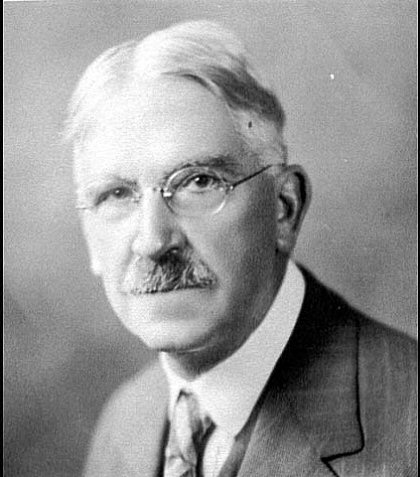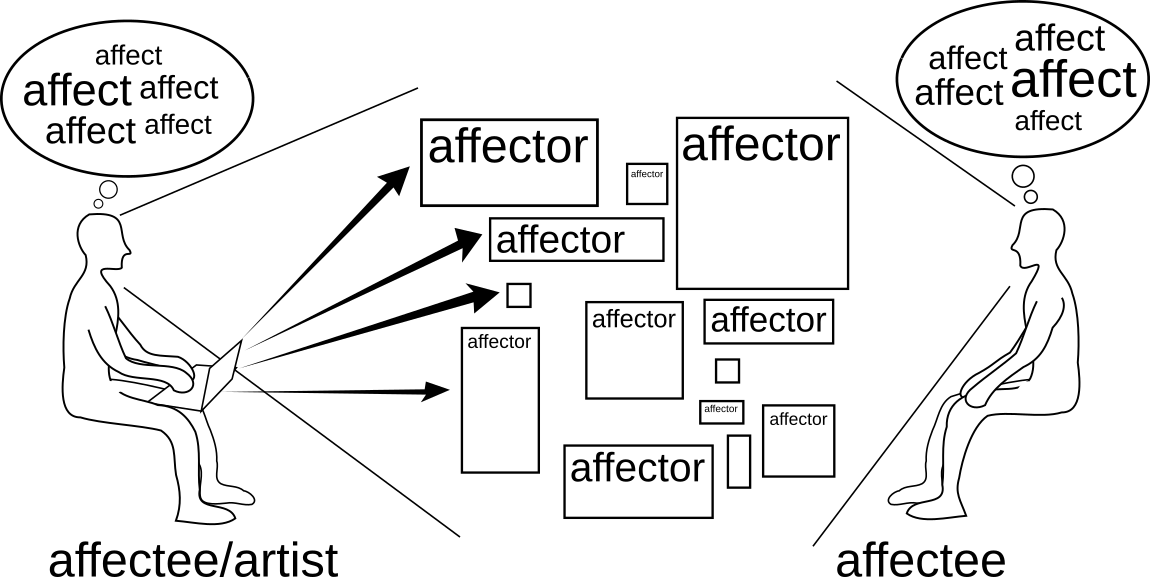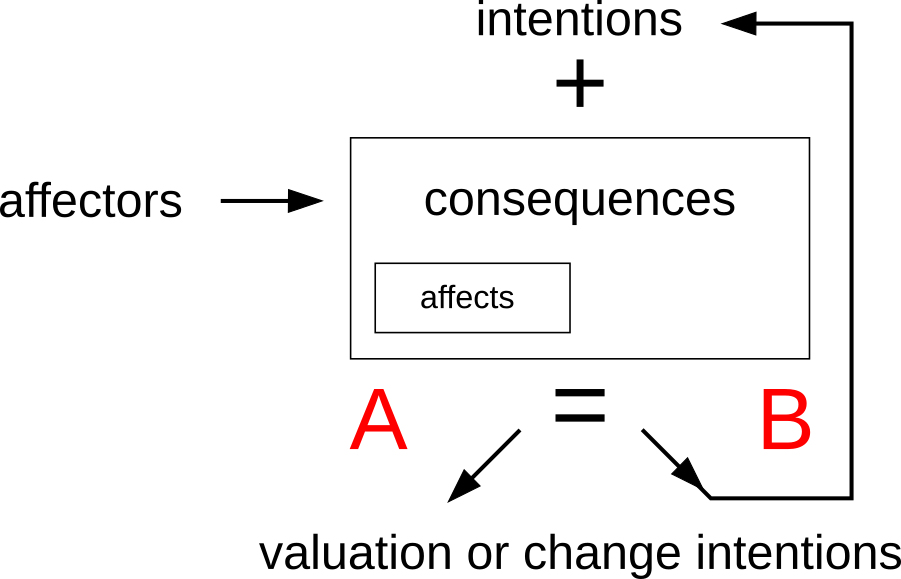Table of Contents
HSE 01, Nov. 6, 2021
a note about the lecture style
- interrupt me anytime if you don't understand, and especially do so because most pieces of information will have consequence for what follows
- hold discussion questions for the end
thanks to Stas and you all for this opportunity!
three discussions on algorithmic art and live coding
- Nov. 6: a pragmatic aesthetic theory
- Nov. 13: layers of algorithmic processes and interaction
- Nov. 20: openness
today's schedule:
- 16:20 - 17:40: discussion of a pragmatic aesthetic theory
- 17:40 - 18:00
- 18:00 - 19:10: thoughts about programming, understanding your projects and goals
outline
- toward a pragmatic aesthetic theory (from my background on)
- a pragmatic aesthetic theory and its application to algorithmic art
- the algorithm as an affector
toward a pragmatic aesthetic theory
my path to and through algorithmic music and art
1981: type-in programs in basic, TI-994A
- type-in programs (in mags like Compute, Byte): https://en.wikipedia.org/wiki/Type-in_program
1987-1988: Kitaro, Vangelis, Wendy Carlos, and my Yamaha PortaSound PSS-470
- Kitaro, Silk Road: https://www.youtube.com/watch?v=ONjMiLMw66g
- Vangelis, Spiral: https://www.youtube.com/watch?v=aVpvFMgPQRI
- this, along with my dad's book collection, simultaneously introduced me to the Tao Te Ching!
- “Going on means going far - Going far means returning” chapter 25
- Stephen Mitchell, Tao Te Ching translation, 1988: https://terebess.hu/english/tao/mitchell.html
- Wendy Carlos, Beauty in the Beast (scales!) https://en.wikipedia.org/wiki/Beauty_in_the_Beast
- Yamaha PortaSound PSS-470: https://www.vintagesynth.com/yamaha/pss470.php
- Music from the Hearts of Space https://en.wikipedia.org/wiki/Hearts_of_Space
1990: Pascal on a Mac: https://en.wikipedia.org/wiki/Pascal_(programming_language)
1994: Max for MIDI, TurboSynth, ARP 2600, Csound
1997: George Brecht's Water Yam
https://en.wikipedia.org/wiki/Water_Yam_(artist%27s_book)
- Fluxus
1999: Adrian Ward's Autoillustrator https://artelectronicmedia.com/en/artwork/auto-illustrator/
2001: Autechre, Confield
2005: SuperCollider
2006: Lisp, Scheme
- The Little Schemer: https://wiki.c2.com/?TheLittleSchemer
2007: Conductive (Haskell), live coding
2015: completed doctoral degree “Affect-Based Aesthetic Evaluation and Development of Abstractions for Rhythm in Live Coding”
2021: Conductive port to JavaScript
research towards a pragmatic aesthetic theory
my doctoral research, which became an essential part of my practice
a need to explain the aesthetic experience of live coding for people who are predominantly visual artists
other aesthetic theories (croce, kant's Critique of Judgment, etc)
- benedetto croce
other thinkers
epistemology, phenomenology, teleology, aesthetics
from dewey to a pragmatic aesthetic theory
John Dewey, Art as Experience: https://plato.stanford.edu/entries/dewey-aesthetics/
dewey's art as experience
aesthetic experience
psychological theories of stimulus and affect
Emotional Responses to Multisensory Environmental Stimuli: A Conceptual Framework and Literature Review (2016)
- useful framework!
- too mechanistic; i don't hold a mechanistic world view, but we ignore neurobiology to our peril
- doesn't map well for art, such as the incongruent stimuli leading to negative valence
- suspect there is a confusion of correlation and causation among the reviewed papers
important affect: arousal and pleasure
“Like Michon et al. (2005), they argued that the novelty of a moderate incongruency probably induced arousal, which mediated favorable evaluations (external perspective). A possible explanation for these findings may be found in Berlyne’s (1960) optimal arousal theory, which suggests that the relation between an individual’s level of arousal and affective state can be represented by a bell-shaped (inverted-U) function. Individuals usually prefer medium levels of arousal. Stimuli causing extreme (either too high or too low) levels of arousal result in negative affect. This could also explain the results found by Morrin and Chebat (2005) and Fenko and Loock (2014).”
“The second is to lay the foundation for a structural and potentially computational and predictive model of the effects of multisensory environmental stimuli on, for instance, emotions or behavior.”
a similar goal to one that i have expressed, to have an aesthetic theory that i can turn into a computation aesthetic judgment system to be employed by AI in the process of algorithmic composition.
a pragmatic aesthetic theory and its application to algorithmic art
pragmatic aesthetic theory
aesthetic experience: the enjoyment of awareness and the recognition of the affect in those, to some extent dissociated with their material meaning for your personal life
affect: a feeling
affector: a percept causing feelings (outer percepts, inner percepts)
affectee: the experiencer of those feelings
radical definition of art and artist
art as a network of affectors that create an aesthetic experience
art exists in the experience of something as an aesthetic experience
to experience something aesthetically makes it into art, and if it wasn't intended that way, you become the artist!
artist: someone who arranges affectors into an aesthetic experience
the artist is the first audience member, though the network of affectors is remarkably different!
things that are or can be art:
- drawing
- painting
- dance
- music
- things considered craft
- sporting events
- sporting event broadcasts
- guided historical walks
- algorithms
is it art or not? boring question…
is it good or bad art? a problematic question (see Tao Te Ching)… thus a turn to a pragmatic aesthetic theory
judgement of aesthetic experience
does the assembled network of affectors achieve the purpose of the work?
- yes: good, enjoy! be aware! learn! then proceed to no…
- no: revise goal or revise art
what is the purpose of the work?
artist vs designer
- artist decides the audience and purpose of the work, the primary purpose being an affective experience
- a designer is told the audience and purpose of the work, and there can be other primary purposes or parallel primary purposes
some stage-related goals:
- experimentation, exploration
- implementation, development
- polishing, refinement, perfection (ha!)
application to algorithmic art
the affector network in algorithmic art
- artistic process
- algorithm
- algorithmic output
- other output
- output device(s)
- medium/media into which output is received
- other environmental factors
- (in performance) the artist (everything about their presence)
- artist persona
- background of the exhibition/event
- background of the audience member
the algorithm as an affector
algorithm as an effector
algorithms not only as functional tools but also as affectors and therefore part of art
how does the user (artist) experience the algorithm?
how does the audience experience the algorithm?
- usability, affordances
- easy or difficult to understand
- fragile or robust
- range of what it can produce
- quality of what it produces
- how well it integrates with other parts of the system
- how does it feel to use it?
algorithm is exposed: direct affector
algorithm is hidden: indirect affector
(will be important in our discussion of openness on Nov. 20!)
types of experience:
- naturalistic vs mechanical or alien
- warm vs cold
- clear or inscrutable
- verbose or concise
- simple or complex (sometimes “a human could do this” vs. “a human couldn't do this”)
- etc
a catalog of algorithms in my musical work… algorithms for:
- generating base rhythms (stochastic, lsystem, euclidean, cropped euclidiean)
- generating variations at various densities
- creating sample patterns
- varying the arrangement of active voices (conductors)
- controlling the conductors
- interaction with the system
- display for me and the audience
goals
affective response i aim for
papers
2013. “Towards Useful Aesthetic Evaluations of Live Coding.” In Proceedings of the International Computer Music Conference. Perth, Australia. http://renickbell.net/pdf/renick-bell-icmc-2013.pdf
2013. “Pragmatic Aesthetic Evaluation of Abstractions for Live Coding.” In Proceedings of Meeting No. 17 of the Japanese Society for Sonic Arts. Nagoya, Japan: The Japanese Society for Sonic Arts. http://www.jssa.info/doku.php?id=journal017
2013. “Considering Interaction in Live Coding through a Pragmatic Aesthetic Theory.” In Proceedings of SI13, NTU/ADM Symposium on Sound and Interactivity. Nanyang Technological University, Singapore. http://soundislands.com/si13/proceedings/papers/04-Considering%20Interaction%20in%20Live%20Coding%20through%20a%20Pragmatic%20Aesthetic%20Theory.pdf
2013. “Pragmatically Judging Generators.” In Proceedings of the Generative Art 2013 Conference. Milan, Italy. http://www.generativeart.com/ga2013xWEB/proceedings1/17.pdf
2014. “Considering Interaction in Live Coding through a Pragmatic Aesthetic Theory.” eContact! 16 (2). http://cec.sonus.ca/econtact/16_2/bell_livecoding.html (This paper is a revised version of the paper with the same title published in 2013.)
unanswered questions and discussion
- questions about the presentation so far
- opinions or feelings about the presentation so far
- references you want to suggest
- other questions
- your expectations or hopes for our remaining two sessions
- … other?
some comments and questions
gleb - clarify “intentions”
ivan - in recorded work, is the algorithm an indirect or direct affector… talked about turning points, music seemed “more formal” than the live recording, the album with fis sounded more like recordings of live performances
ivan - if it's all about affect, the algorithm is an affector, made me think about the manipulating the perception, now i see a practice ot use algorithm as an attempt to have more control on music perception
ivan - choosing an algorithm, still manipulating yourself,
olga - ai, neural network, representing human ethic problems, reflecting on it and talking about it is one of the solutions, agreed with the media representation of AI, more open and wide discussion it would help
ivan - what do you htink about the future of this kind of culture
ivan - new extensions, a screen with code, maybe in the future there will be some new kinds of extensions for affecting perception
gleb - overview of algorithmic music (musicians, techniques, concepts)
vlad - when we learn max and PD, the main thing we learned were creating thigns that are not really difficult and sequencing, like pd but only making sequencers, to make cool sounds it takes a lot of time, hear examples from you how to make it easier to generate complex timbres
ivan - learn some warping techniques, interesting techniques of working with samples
maria - worried she is slow, and just wants to get the method
vlad - how to prepare a big live set in terms of strategy and logic
olga - i have lots of struggle with live, i want to control everything, i need some freedom, how to control the parameters
maria - inspiriring to hear about poetic text while algorithmic coding, when you interact with people
vlad - maybe i know some examples of other ways to communicate with audience, but not text, maybe sensors, or not with one human or the whole dancefloor, source to take information to generate other things, data sonification, data sonification with feedback is more interesting
part 2, introductions and programming
guided introductions, workshop
email to renick@gmail.com
- name
- professional status or aspiration
- three world-view references
- your programming experience (including HTML and visual patchers, modular synthesis)
- your current work or a recent work
- who is the audience for your work?
- what is the goal of your work?
- analyze your own work in regards to a network of affectors
- what affective response do you want? how do you intend to provoke it?
today: what you can write in 10 minutes
for next time: just a bit more thought and detail, + links!
thoughts on programming
a short side-note: why text based coding instead of a patcher
decomposing a problem into solvable subproblems
writing code so that you can understand it later
learning to do abstraction (creating reusable parts)



